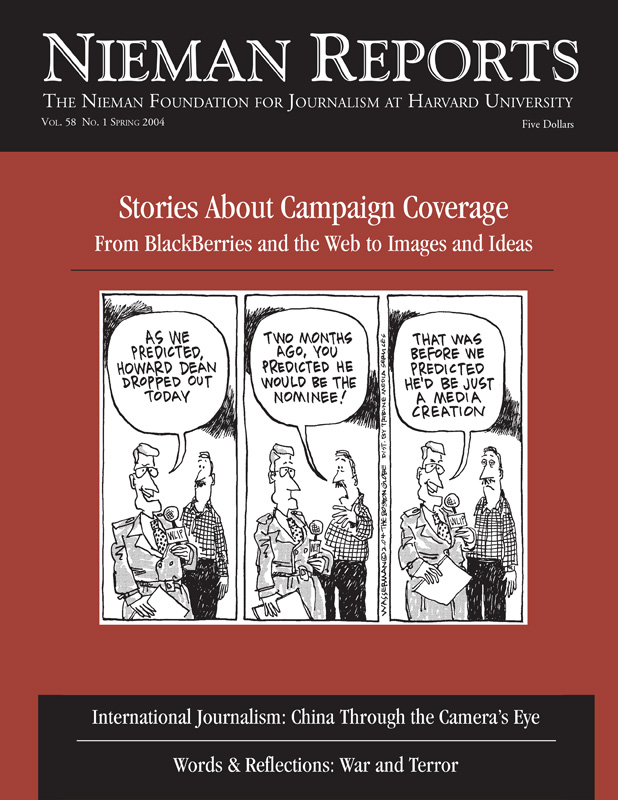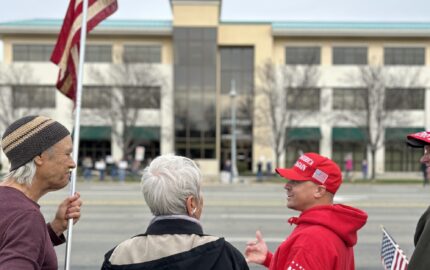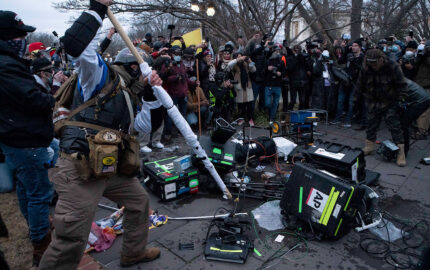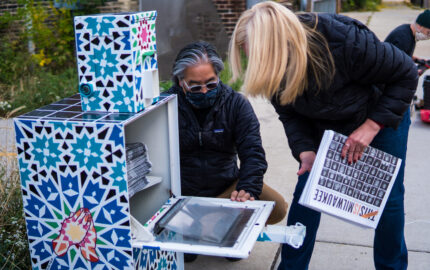
Stories About Campaign Coverage
In his essay “Only a Lunatic Would Do This Kind of Work,” David M. Shribman, executive editor of the Pittsburgh Post-Gazette, captures the essence of what motivates political journalists. “They have an ethos,” Shribman writes. “They believe in inquiry. They believe in the value of the pointed question. They believe in catching their prey in an unscripted moment or in a lie. They believe in asking impertinent questions of their social betters. They believe small deviations from a candidate’s basic stump speech have grave implications.” – Melissa Ludtke, Editor
No reporting beat, with the possible exception of covering a hometown team, is as closely watched, as thoroughly analyzed, and as consistently driven by what the new technology allows journalists to do as is political reporting. In his essay “Only a Lunatic Would Do This Kind of Work,” David M. Shribman, executive editor of the Pittsburgh Post-Gazette, captures the essence of what motivates political journalists. “They have an ethos,” Shribman writes. “They believe in inquiry. They believe in the value of the pointed question. They believe in catching their prey in an unscripted moment or in a lie. They believe in asking impertinent questions of their social betters. They believe small deviations from a candidate’s basic stump speech have grave implications.”
Walter R. Mears reported political news for 45 years, nearly all of them for The Associated Press. Having retired (and written the book, “Deadlines Past: Forty Years of Presidential Campaigning: A Reporter’s Story,” about his work), Mears casts an observer’s eye on this cycle’s coverage. One complaint: “I am frustrated as a reader when I see stories that cry for background, statistics, history—explanatory touches that put the event of the hour into perspective. Those added words are worth the space and the effort to get the data. It isn’t difficult.” John Harwood, political editor of The Wall Street Journal, first experienced a political campaign when he accompanied his father, Richard Harwood, also a political reporter, in 1968. When his father filed stories, his son writes, they “contained news of first impression for his editors and the vast majority of his readers.” With cable TV and the Internet, that is no longer true so, as Harwood observes, “stories I write must command the attention of readers less by the news they contain than by the analysis they offer.”
When David Yepsen, political columnist for The Des Moines Register, looks at reporters’ analyses, he often wishes they had spent less time following candidates and more time learning from voters. “It’s time for more of us horserace journalists to get down into the paddocks, talk to the jockeys, the owners, and the breeders as well as the fans,” he writes. Terry Michael, executive director of the Washington Center for Politics & Journalism, argues that in their role as handicappers of the political race, journalists should focus on themes other than money, ads, staff and calendar. Four key factors he urges them to rely on during primary campaigns are what he describes as base, biography, edge and effort.
When North Carolina Senator John Edwards became a presidential candidate, John Wagner, a Washington-based reporter for The (Raleigh, N.C.) News & Observer, went on the road to cover his campaign and report to home state readers. After more than two years of doing so, he raises a fundamental question about such coverage when he asks of his newspaper’s coverage: “Are we covering the presidential race, or are we covering how Edwards fares in the presidential race? Or both and, if so, how do we strike a balance between these two objctives?” Steven Scully, C-SPAN’s political editor, uses his network’s experience as a window to explore many of the changes in how New Hampshire’s presidential primary race is covered. Most noteworthy is the digital revolution “making it possible for hundreds of local, international and alternative media to cover the race right alongside the national media.”
Michael Tackett, the Chicago Tribune’s political editor, describes how “technology is transforming the coverage of politics for reporters and not necessarily for the better.” Given the speed with which news is transmitted, he writes, “too many of us are forced to react now and reflect later …. Often we spend too much time electronically chasing many rabbits within and among campaigns and too little time talking to voters who decide elections.” Mark Seibel, who directed The Miami Herald’s review of the disputed Florida ballots in the 2000 presidential election, explains why reporters should be focusing attention not only on what happens on the campaign trail but also in the voting booth, where changes in technology are creating new, faster and potentially more unreliable balloting systems.
The Web has arrived as a powerful political medium. For reporters, its allure is in its easy accessibility, its connective links, its abundant analysis, and its research capability. But as Adam Reilly, a first-time political reporter at the Boston Phoenix, reports, his daily look at political Web sites became an obsession and, in turn, a reporting liability. “… what I’d envisioned as background reading to help me do my job more effectively was eating into valuable reporting time,” he says. Elizabeth Wilner, political director of NBC News and coauthor of its Web publication, First Read, tells how and why the networks publish these daily mixtures of reporting and analysis. “This investment of time yields original content, and that adds cachet to the Web site,” she writes. Chris Lydon, who in the 1970’s wrote about presidential campaigns for The New York Times and now does so on his Weblog, writes about the role the Internet plays in campaign coverage and how it is not possible to separate the “‘political’ and ‘media’ tracks of the Howard Dean campaign’s offensive.” Wayne Woodlief, who was chief political columnist with the Boston Herald for 27 years, writes about the difference between interviewing a Dean supporter online and then going to a coffee bar to listen to voters. And James W. Pindell, managing editor for PoliticsNH.com, describes how “portable gadgets—my cell phone, BlackBerry, wireless e-mail device, and a laptop” enable him to report and run the Web site from his on-the-road newsroom.
Meryl Levin and Will Kanteres, whose upcoming book “Primarily New Hampshire” documents the day-to-day experiences of campaign staffers, share photographs and words they collected in the year leading up to the New Hampshire primary. Luis Rios, director of photography for The Miami Herald, explores how photographers and photo editors try to overcome the strategic efforts of political operatives to arrange only flattering photo-op images. “When editors make decisions day after day to publish photographs that are conspicuously photo ops, over time they send a message to readers about the kind of images they think worthy of publication,” he writes. Kenny Irby, visual journalism group leader at The Poynter Institute, details essential questions for editors and photographers to ask in deciding whether to publish pictures from the campaign trail. And Dan Habib, photo editor for the Concord (N.H.) Monitor, describes how his team of photographers gained access to the presidential candidates to offer their readers unexpected and unscripted views.
We end by offering a political reporter’s toolbox, assembled in a roundtable discussion with veteran reporters convened by the Committee of Concerned Journalists. Among the tools are ways to “find the invisible campaign,” to use polls more productively, to examine their biases, and to identify (and avoid) the meta-narratives of the campaign.
Walter R. Mears reported political news for 45 years, nearly all of them for The Associated Press. Having retired (and written the book, “Deadlines Past: Forty Years of Presidential Campaigning: A Reporter’s Story,” about his work), Mears casts an observer’s eye on this cycle’s coverage. One complaint: “I am frustrated as a reader when I see stories that cry for background, statistics, history—explanatory touches that put the event of the hour into perspective. Those added words are worth the space and the effort to get the data. It isn’t difficult.” John Harwood, political editor of The Wall Street Journal, first experienced a political campaign when he accompanied his father, Richard Harwood, also a political reporter, in 1968. When his father filed stories, his son writes, they “contained news of first impression for his editors and the vast majority of his readers.” With cable TV and the Internet, that is no longer true so, as Harwood observes, “stories I write must command the attention of readers less by the news they contain than by the analysis they offer.”
When David Yepsen, political columnist for The Des Moines Register, looks at reporters’ analyses, he often wishes they had spent less time following candidates and more time learning from voters. “It’s time for more of us horserace journalists to get down into the paddocks, talk to the jockeys, the owners, and the breeders as well as the fans,” he writes. Terry Michael, executive director of the Washington Center for Politics & Journalism, argues that in their role as handicappers of the political race, journalists should focus on themes other than money, ads, staff and calendar. Four key factors he urges them to rely on during primary campaigns are what he describes as base, biography, edge and effort.
When North Carolina Senator John Edwards became a presidential candidate, John Wagner, a Washington-based reporter for The (Raleigh, N.C.) News & Observer, went on the road to cover his campaign and report to home state readers. After more than two years of doing so, he raises a fundamental question about such coverage when he asks of his newspaper’s coverage: “Are we covering the presidential race, or are we covering how Edwards fares in the presidential race? Or both and, if so, how do we strike a balance between these two objctives?” Steven Scully, C-SPAN’s political editor, uses his network’s experience as a window to explore many of the changes in how New Hampshire’s presidential primary race is covered. Most noteworthy is the digital revolution “making it possible for hundreds of local, international and alternative media to cover the race right alongside the national media.”
Michael Tackett, the Chicago Tribune’s political editor, describes how “technology is transforming the coverage of politics for reporters and not necessarily for the better.” Given the speed with which news is transmitted, he writes, “too many of us are forced to react now and reflect later …. Often we spend too much time electronically chasing many rabbits within and among campaigns and too little time talking to voters who decide elections.” Mark Seibel, who directed The Miami Herald’s review of the disputed Florida ballots in the 2000 presidential election, explains why reporters should be focusing attention not only on what happens on the campaign trail but also in the voting booth, where changes in technology are creating new, faster and potentially more unreliable balloting systems.
The Web has arrived as a powerful political medium. For reporters, its allure is in its easy accessibility, its connective links, its abundant analysis, and its research capability. But as Adam Reilly, a first-time political reporter at the Boston Phoenix, reports, his daily look at political Web sites became an obsession and, in turn, a reporting liability. “… what I’d envisioned as background reading to help me do my job more effectively was eating into valuable reporting time,” he says. Elizabeth Wilner, political director of NBC News and coauthor of its Web publication, First Read, tells how and why the networks publish these daily mixtures of reporting and analysis. “This investment of time yields original content, and that adds cachet to the Web site,” she writes. Chris Lydon, who in the 1970’s wrote about presidential campaigns for The New York Times and now does so on his Weblog, writes about the role the Internet plays in campaign coverage and how it is not possible to separate the “‘political’ and ‘media’ tracks of the Howard Dean campaign’s offensive.” Wayne Woodlief, who was chief political columnist with the Boston Herald for 27 years, writes about the difference between interviewing a Dean supporter online and then going to a coffee bar to listen to voters. And James W. Pindell, managing editor for PoliticsNH.com, describes how “portable gadgets—my cell phone, BlackBerry, wireless e-mail device, and a laptop” enable him to report and run the Web site from his on-the-road newsroom.
Meryl Levin and Will Kanteres, whose upcoming book “Primarily New Hampshire” documents the day-to-day experiences of campaign staffers, share photographs and words they collected in the year leading up to the New Hampshire primary. Luis Rios, director of photography for The Miami Herald, explores how photographers and photo editors try to overcome the strategic efforts of political operatives to arrange only flattering photo-op images. “When editors make decisions day after day to publish photographs that are conspicuously photo ops, over time they send a message to readers about the kind of images they think worthy of publication,” he writes. Kenny Irby, visual journalism group leader at The Poynter Institute, details essential questions for editors and photographers to ask in deciding whether to publish pictures from the campaign trail. And Dan Habib, photo editor for the Concord (N.H.) Monitor, describes how his team of photographers gained access to the presidential candidates to offer their readers unexpected and unscripted views.
We end by offering a political reporter’s toolbox, assembled in a roundtable discussion with veteran reporters convened by the Committee of Concerned Journalists. Among the tools are ways to “find the invisible campaign,” to use polls more productively, to examine their biases, and to identify (and avoid) the meta-narratives of the campaign.


